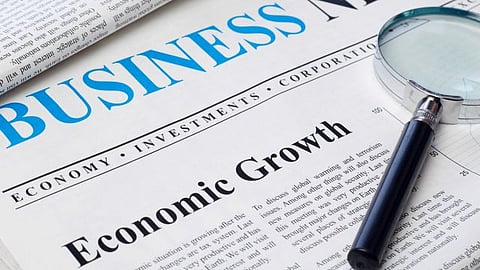India’s Economic Growth
Understanding India’s Economic Growth: Trends and Outlook
Policymakers around the globe are currently facing a challenging situation. In the last three years, the world economy has encountered numerous crises simultaneously, with the most recent one involving liquidity problems triggered by a series of global bank emergencies.
Although efforts have been made to limit the damage, consumers' and companies' lingering lack of trust hinders economic growth.
Is change coming?
Despite the gloom, many experts in the financial sector predict that this decade might prove to be India's breakthrough.
The Indian government has been revising its economic data, and the results imply the economy is doing better than was previously thought — ongoing global worries notwithstanding. The IMF forecasts that India's economy will expand by 5.9% in FY 2023-24 and 6.1% over the next five years.
This extensive review examines the current state and prospects of the Indian economy. We aim to present a complete picture of India's economic situation by analyzing various forex indicators, industry subsectors, and government initiatives.
Opportunities and challenges in India’s economic outlook
Opportunities and challenges in India’s economic outlook
Consumption and investment account for 70% of India's GDP, making it a predominantly demand-driven economy. There have been numerous investments and advancements due to an improvement in the perception of the country’s economy and the recovery of the same.
According to the World Bank, India must continue to focus on reducing inequality and implementing growth-oriented policies to stimulate economic growth.
Given India's sizable, youthful, and growing percentage of the upper middle-income population — betting on consumption-driven development seems logical.
However, investments will be crucial during the next two years. Without them, India cannot launch itself into a trajectory of long-term, demand-led growth.
Unfortunately, investment in physical assets has lagged, particularly in the private sector. Industry in India will benefit greatly from the government's efforts to improve infrastructure through Prime Minister Gati Shakti's initiative (National Master Plan for Multimodal Connectivity), as well as the government's focus on logistics and industrial corridor development.
Consumer spending will increase due to an improved job environment and consumer confidence. Despite aiming for a smaller budget deficit of 5.9% of GDP in FY2023, the federal government has committed to considerably increasing capital investment.
In FY2023 and FY2024, the services sector will rise rapidly thanks to a rebound in tourism and other contact services. However, sluggish global demand is predicted to slow industrial expansion in FY2023, though things should pick up in FY2024.
Maintaining agriculture growth over the medium term will depend on recent initiatives to increase production, establish digital crop planning services, and provide farm business assistance, for example.
Inflation is projected to fall to 5% in FY2023 and 4.5% in FY2024, assuming further oil and food costs decline.
As core inflation remains persistent, monetary policy will tighten in FY2023 before loosening in FY2024. In FY2023 and FY2024, the current account deficit is expected to shrink to 2.2% and 1.9% of GDP, respectively.
Export growth will slow in FY2023 but increase in FY2024 due to improved performance in electronics and other manufacturing sectors. This is due to production-linked incentive programs and attempts to enhance the business climate — like reduced labor rules.
India's balance of payments is likely to continue improving because of the country's booming services exports. Nevertheless, significant threats (geopolitical tensions and weather-related disruptions) to India's economic future remain.
The revised GDP figures highlight the historical resilience of the country
The revised GDP figures highlight the historical resilience of the country
The Indian government has issued GDP projections for the third quarter of the fiscal year 2022-23 (October-December) and revised figures for the previous three years.
According to GDP figures, India has emerged from the global gloom in better shape than was first thought. Growth picked up consistent speed beginning in FY 2022-23.
An upward revision of 0.77 percentage points to GDP growth in FY2020-21 suggests the recession was less than initially estimated.
Meanwhile, growth projections for FY 2021-22 increased from 8.7% to 9.1% — indicating a more robust recovery. The manufacturing and construction sectors contributed significantly more than expected to this upward revision.
The most recent quarter's data (Q3) suggests annual growth of 4.4%. Despite being the weakest quarter of the current fiscal year, this year's growth predictions were strengthened by a significant upward adjustment of last year's statistics, substantially improving the baseline.
Exports did well despite the worldwide downturn, perhaps due to the weaker currency's performance versus the dollar. Global exports of products remained low, while exports of services from India increased by 30% between April and February.
Strong global digitization drives, cost-cutting efforts by firms to deal with the looming recession, and the rising trend of remote working all contributed to a rise in demand for Indian exports of technological services.
Notably, government spending has decreased for two quarters, indicating budgetary restraint and discipline. The public administration services sector also saw a slowdown in GVA growth.
The fiscal deficit over the first ten months of the fiscal year equaled 67.8% of the planned deficit for the whole fiscal year.
This year's budget presentation reflects the government's optimistic efforts in expense management. It has the potential to lead to a reduction of the fiscal deficit to below 4.5% by 2025-26.
The economic projections
Despite recent setbacks, experts are optimistic about India's economic future. They anticipate a revival in investment activity, which would propel the country's economy into sustained development.
As the global economy continues to suffer, India's GDP is expected to rise sluggishly from 6.0%-6.5% in FY 2023-24. With favorable demographics providing support over the next few years, investments will likely spur a surge in growth. This will increase employment, income, productivity, demand, and exports.
Our global community has emerged from the darkness cast by the global pandemic and adjusted to the new reality. However, geopolitical crises, supply chain reorientations, worldwide inflation, and stringent monetary policy circumstances will dampen the outlook.
Follow us on Google News


